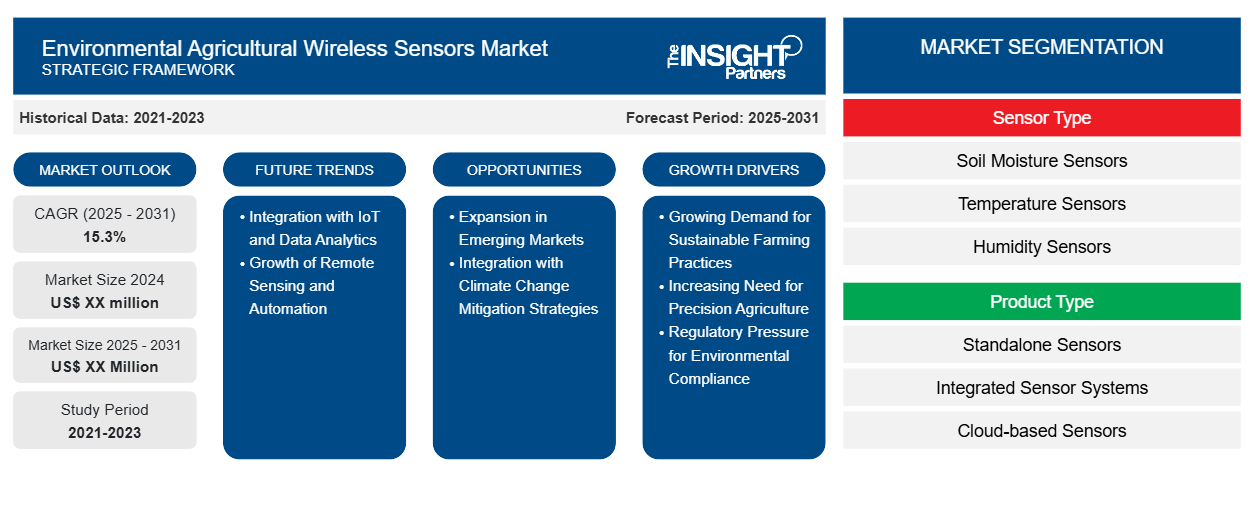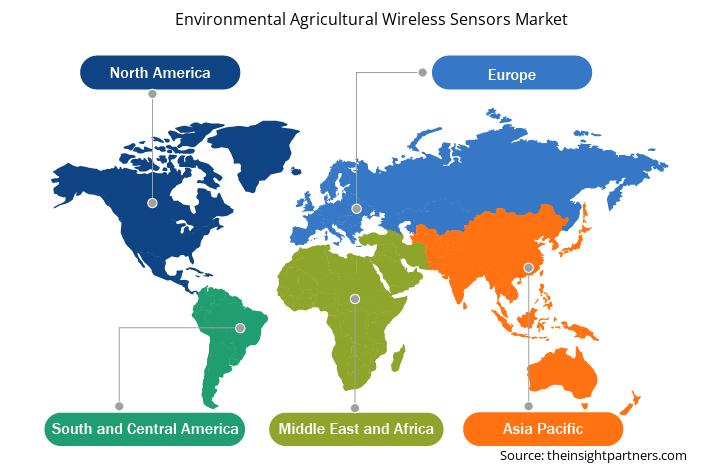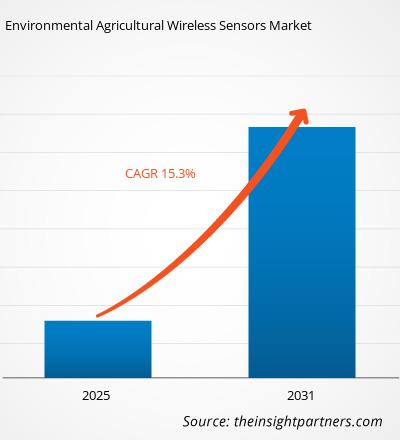環境農業ワイヤレスセンサー市場は、2025年から2031年にかけて15.3%のCAGRで成長し、市場規模は2024年のXX百万米ドルから2031年にはXX百万米ドルに拡大すると予想されています。
レポートは、センサータイプ(土壌水分センサー、温度センサー、湿度センサー、栄養センサー)、製品タイプ(スタンドアロンセンサー、統合センサーシステム、クラウドベースセンサー)、アプリケーション(精密農業、土壌健康モニタリング、作物モニタリング、天気予報)、最終用途(農業生産者、農業サービス、研究機関)別にセグメント化されています。グローバル分析は、地域レベルと主要国でさらに細分化されています。レポートは、上記の分析とセグメントに対して米ドルでの価値を提供します。
報告書の目的
The Insight Partners による環境農業ワイヤレスセンサー市場レポートは、現在の状況と将来の成長、主な推進要因、課題、機会を説明することを目的としています。これにより、次のようなさまざまなビジネス関係者に洞察が提供されます。
- テクノロジープロバイダー/メーカー: 進化する市場の動向を理解し、潜在的な成長機会を把握することで、情報に基づいた戦略的意思決定が可能になります。
- 投資家: 市場の成長率、市場の財務予測、バリュー チェーン全体に存在する機会に関する包括的な傾向分析を実施します。
- 規制機関: 市場の濫用を最小限に抑え、投資家の信用と信頼を維持し、市場の完全性と安定性を維持することを目的として、市場における政策と警察活動を規制します。
環境農業無線センサー市場のセグメンテーション
センサータイプ
- 土壌水分センサー
- 温度センサー
- 湿度センサー
- 栄養センサー
製品タイプ
- スタンドアロンセンサー
- 統合センサーシステム
- クラウドベースのセンサー
応用
- 精密農業
- 土壌の健康モニタリング
- 作物モニタリング
- 天気予報
最終用途
- 農業生産者
- 農業サービス
- 研究機関
要件に合わせてレポートをカスタマイズする
このレポートの一部、国レベルの分析、Excelデータパックなど、あらゆるレポートを無料でカスタマイズできます。また、スタートアップや大学向けのお得なオファーや割引もご利用いただけます。
環境農業無線センサー市場:戦略的洞察

- このレポートの主要な市場動向を入手してください。この無料サンプルには、市場動向から見積もりや予測に至るまでのデータ分析が含まれます。
環境農業無線センサー市場の成長要因
- 持続可能な農業慣行に対する需要の高まり: 農業分野がより持続可能な慣行へと移行するにつれて、ワイヤレス センサーは水、肥料、農薬などの資源の使用を最適化するための不可欠なツールになりつつあります。これらのセンサーは環境条件をリアルタイムで監視するのに役立ち、農家は無駄を減らして全体的な持続可能性を向上させることができます。
- 精密農業のニーズの高まり: 精密農業の台頭により、ワイヤレス センサーは作物の監視と管理を強化する上で極めて重要な役割を果たします。これらのセンサーは土壌の水分、温度、栄養レベルなどのデータを提供し、農家は環境への影響を最小限に抑えながら作物の収穫量を向上させるためのより情報に基づいた決定を下すことができます。
- 環境コンプライアンスに対する規制圧力: 環境規制の厳格化と持続可能性の目標により、農業におけるワイヤレス センサーの導入が進んでいます。これらのセンサーは、水の使用、土壌の健全性、排出制御などの環境基準を農家が監視して遵守するのに役立ち、環境管理の改善と罰金や罰則のリスクの軽減を実現します。
環境農業無線センサー市場の将来動向
- IoT およびデータ分析との統合: ワイヤレス センサーを IoT (モノのインターネット) および高度なデータ分析と統合するトレンドが、農業を変革しています。リアルタイムでデータを収集して分析することで、農家は灌漑を最適化し、作物の病気を予測し、土壌の健康状態を評価することができ、より効率的で生産性の高い農業慣行が可能になります。
- リモート センシングと自動化の発展: ドローンや衛星ベースのモニタリングなどのリモート センシング技術は、ワイヤレス センサーと組み合わされて、詳細な環境データを収集しています。この傾向により、大規模な農地をリアルタイムで監視する自動化農業システムが可能になり、人件費が削減され、運用効率が向上します。
環境農業無線センサー市場機会
- 新興市場での拡大: 農業部門が最新技術を導入している新興市場では、環境農業ワイヤレス センサーの需要が高まっています。アジア太平洋、アフリカ、ラテン アメリカなどの地域の国々は、生産性の向上、持続可能性の向上、環境への影響の削減を目的として精密農業に投資しており、センサー ベースのソリューションの機会を生み出しています。
- 気候変動緩和戦略との統合: 気候変動に対する懸念が高まる中、土壌水分、空気の質、気温変動など、農業に影響を与える環境パラメータを監視するためにワイヤレス センサーを使用する機会が増えています。これらのセンサーは、農家が気候リスクを軽減し、変化する気象条件に適応するために慣行を調整するのに役立ち、気候対応型農業の成長に大きな可能性をもたらします。
環境農業ワイヤレスセンサー市場地域別洞察
予測期間を通じて環境農業ワイヤレスセンサー市場に影響を与える地域的な傾向と要因は、Insight Partners のアナリストによって徹底的に説明されています。このセクションでは、北米、ヨーロッパ、アジア太平洋、中東、アフリカ、南米、中米にわたる環境農業ワイヤレスセンサー市場のセグメントと地理についても説明します。

- 環境農業ワイヤレスセンサー市場の地域別データを入手
環境農業無線センサー市場レポートの範囲
| レポート属性 | 詳細 |
|---|---|
| 2024年の市場規模 | XX百万米ドル |
| 2031年までの市場規模 | XX百万米ドル |
| 世界のCAGR(2025年~2031年) | 15.3% |
| 履歴データ | 2021-2023 |
| 予測期間 | 2025-2031 |
| 対象セグメント | センサータイプ別
|
| 対象地域と国 | 北米
|
| 市場リーダーと主要企業プロフィール |
|
環境農業ワイヤレスセンサー市場のプレーヤー密度:ビジネスダイナミクスへの影響を理解する
環境農業ワイヤレスセンサー市場は、消費者の嗜好の変化、技術の進歩、製品の利点に対する認識の高まりなどの要因により、エンドユーザーの需要が高まり、急速に成長しています。需要が高まるにつれて、企業は提供を拡大し、消費者のニーズを満たすために革新し、新たなトレンドを活用し、市場の成長をさらに促進しています。
市場プレーヤー密度とは、特定の市場または業界内で活動している企業または会社の分布を指します。これは、特定の市場スペースに、その市場規模または総市場価値に対してどれだけの競合相手 (市場プレーヤー) が存在するかを示します。
環境農業ワイヤレスセンサー市場で事業を展開している主要企業は次のとおりです。
- デカゴンデバイス
- リベリウム
- テラリティック
- ファーモビル
- ボッシュ
免責事項:上記の企業は、特定の順序でランク付けされていません。

- 環境農業ワイヤレスセンサー市場のトップキープレーヤーの概要を入手
主なセールスポイント
- 包括的なカバレッジ: レポートでは、環境農業ワイヤレス センサー市場の製品、サービス、タイプ、エンド ユーザーの分析を包括的にカバーし、全体的な概要を提供します。
- 専門家による分析: レポートは、業界の専門家とアナリストの深い理解に基づいてまとめられています。
- 最新情報: このレポートは、最新の情報とデータの傾向を網羅しているため、ビジネスの関連性を保証します。
- カスタマイズ オプション: このレポートは、特定のクライアント要件に対応し、ビジネス戦略に適切に適合するようにカスタマイズできます。
したがって、環境農業ワイヤレスセンサー市場に関する調査レポートは、業界のシナリオと成長の見通しを解読し理解する道の先導役となる可能性があります。正当な懸念事項がいくつかあるかもしれませんが、このレポートの全体的な利点は欠点を上回る傾向があります。
- 過去2年間の分析、基準年、CAGRによる予測(7年間)
- PEST分析とSWOT分析
- 市場規模価値/数量 - 世界、地域、国
- 業界と競争環境
- Excel データセット
最新レポート
関連レポート
お客様の声
購入理由
- 情報に基づいた意思決定
- 市場動向の理解
- 競合分析
- 顧客インサイト
- 市場予測
- リスク軽減
- 戦略計画
- 投資の正当性
- 新興市場の特定
- マーケティング戦略の強化
- 業務効率の向上
- 規制動向への対応




















 無料サンプルを入手 - 環境農業用ワイヤレスセンサー市場
無料サンプルを入手 - 環境農業用ワイヤレスセンサー市場